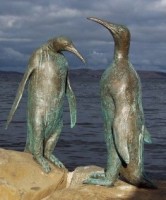NIGEL S. ROBERTS Penguins |
||
During the 1979-80 Southern Hemisphere summer, I was privileged to be able to spend four months in Antarctica, working as the Information Officer / Photographer at Scott Base for the New Zealand Department of Scientific and Industrial Research. While I was in Antarctica, I saw and photographed two species of penguins – namely, Adelie penguins and Emperor penguins. There are 17 species of penguins in the world*, and I have set myself a goal of photographing all 17 species. There are two reasons for this: not only are penguins attractive, interesting and amusing birds, but they are also found in wonderful, wild and exotic locations. In alphabetical order, the 17 species of penguin are —
— and the following picture of all 17 penguin species is a result of a "photostitch" that I made from a series of three photographs taken in the New England aquarium in October 2006.
From left to right, the penguins in the above "photostitch" are Emperor, King, Gentoo, Chinstrap, Adelie, Yellow-Eyed, Royal, Macaroni, Erect-crested, Snares, Fiordland, Rockhopper, Magellanic, Humboldt, African, Galapagos, and Little penguins Photographs that I have taken of penguins are included in this website. To see them, simply click on the species in the list above whose names are given in blue type. In all modesty, I regard the photos that I took of Adelie and Emperor penguins in Antarctica as good, and I am proud to show them on this website. Outside Antarctica, I have photographed six other penguin species: African (or Cape) penguins, Humboldt penguins, Little (or Fairy) penguins, King penguins, Rockhopper penguins, and Yellow-Eyed penguins. However, my photograph of King penguins was taken at the Jurong Bird Park in Singapore; my photograph of an African (or Cape) penguin was taken at the New England aquarium in Boston, Massachusetts; and my Humboldt and Rockhopper penguin photos were taken at the Skansen zoo in Stockholm, so they don't really count. What is more, although I have taken photos of Little (or Fairy) penguins and of Yellow-Eyed penguins in the wild, they were not good photos. Most of the Little penguins I have photographed have been while I've been bobbing around on Wellington harbour in my sea-kayak, and the penguins have been barely more than blurred dots on the water. An example of one such photo is included on this website, and — because the Little penguin is so small in the photo that it's really impossible to tell that it's even a penguin — the photograph has been supplemented by a picture I took in the New England aquarium of two Little penguins. Similarly, when I took pictures of Yellow-Eyed penguins they were either far away or it was dark and I was not allowed to use a flash. In brief, even though I have put photos of African, Humboldt, King, Little, Rockhopper, and Yellow-Eyed penguins onto this website, they were either taken in aquariums and zoos or they're not very good, so — as I've already said — they don't really count. Thus, when it comes to photographing penguin species, it's really a case of two down and fifteen to go. It's also literally a case of watch this space ... Endnote ********** Pages in the Penguins section of my website were last revised on 13 March 2007. |
||

